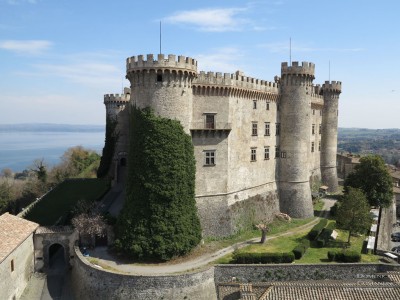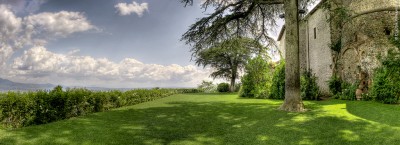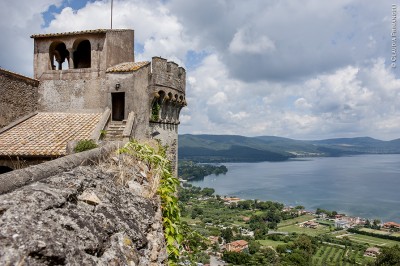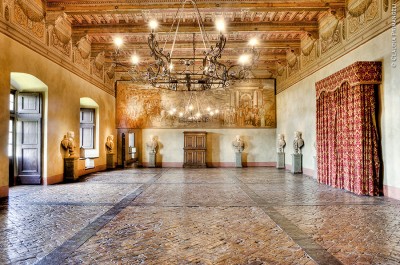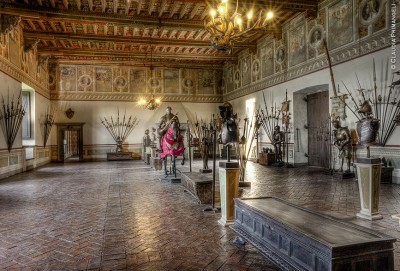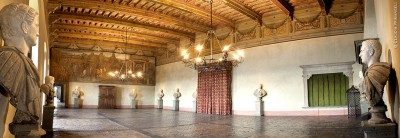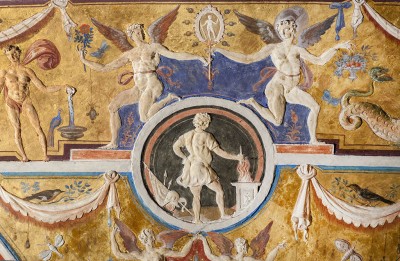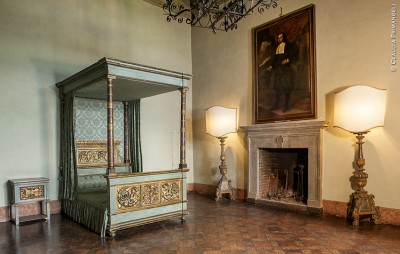Contact the abode
THE ORSINI-ODESCALCHI CASTLE ON THE SHORES OF LAKE BRACCIANO IS ONE OF THE MOST BEAUTIFUL RENAISSANCE RESIDENCES IN EUROPE, A REMARKABLE ESTATE RICH IN HISTORICAL AND ARCHITECTURAL LAYERS
CASTELLO ORSINI-ODESCALCHI ON THE SHORES OF LAKE BRACCIANO
Castello Odescalchi di Bracciano is a complex that could well be described as a true palimpsest of history and architecture, a sort of living organism in terms of its multiple transformations, adaptations, restorations and expansions. In essence, four primary commissioning phases can be identified.
Firstly came the construction of the Rocca Vecchia (or Ancient Fortress), the late medieval centrepiece of the Castle, which was built around 1200 by the Prefects of Vico who administered a large part of Tuscia between Rome and Viterbo.
Secondly, following the transition of ownership from the Vico family to the Orsini family, the Castle underwent extensive expansion and remodelling under the guidance of Napoleone Orsini and his son Gentile Virginio between 1470 and 1496. During this period, it is likely that architects Giovannino de Dolci, who also worked on the Sistine Chapel, as well as Francesco di Giorgio Martini, Antoniazzo Romano and potentially Andrea Bregno and Giovanni Dalmata, were involved in the construction, fortification, and embellishment of the structure. It was precisely at this time that the most monumental Palazzos of the early Renaissance were being commissioned (for example, the Ducal Palace of Urbino, the Medici Palace in Florence, the Castelnuovo in Naples, Palazzo Venezia in Rome), and these were buildings and patrons that the Orsini family knew and wished to emulate. Almost simultaneously, the Orsini family restored and built buildings in Rome (Montegiordano and Campo de Fiori), as well as in Tagliacozzo, Vicovaro, Avezzano and Scurcola Marsicana, but it would appear that Bracciano was becoming ever more symbolic of the family’s increasing military power.
The third commissioning phase saw the transformation of a fortress into a noble Palazzo at the behest of Paolo Giordano Orsini when Bracciano was named a duchy in 1560 and the first Duke married Isabella de’ Medici in 1558. Paolo Giordano duly summoned architects Giacomo del Duca and Nanni di Baccio Bigio at intermittent periods, along with painters Taddeo and Federico Zuccari, who, as Vasari testified, painted some of their most precious works in this Castle.
The fourth and final installment occurred when the crisis of the baronial families in the Baroque era led the Orsini family to sell the Castle to the Odescalchi family at the end of the 17th century during the papacy of Innocent XI.
Sold to the Torlonia family for a brief period, the estate was repurchased by the Odescalchi family in the second half of the 19th century under the ‘jus redimendi’ right of redemption, thanks to a fortunate marriage between Livio Odescalchi and Polish princess Sofia Branicka. In 1890, Prince Baldassarre Odescalchi, known for his refined taste, collaborated with his trusted architect, Raffaele Ojetti, to undertake alterations. In a harmonious partnership, the patron and architect worked together to restore the Castle, taking inspiration from the ideas of John Ruskin and the principles of the Renaissance whenever feasible.
Opened to the public since 1952, the current management of the Foundation dedicated to Prince Livio IV Odescalchi has been instrumental in the ongoing preservation and restoration of this historic site.
THE HISTORY OF CASTELLO ODESCALCHI: ONE OF THE MOST BEAUTIFUL RENAISSANCE RESIDENCES IN EUROPE
The construction of the Odescalchi Castle in Bracciano, possibly based on a design by architect Francesco di Giorgio Martini, began in 1470 upon the commission of Napoleone Orsini and was completed in 1485 under the guidance of his son, Gentile Virginio.
Over the centuries, the building underwent a number of significant transformations, and because of its strategic position, often found itself at the centre of bitter disputes between Rome’s most important noble dynasties, such as the Colonna and Borgia families. Pope Alexander VI Borgia went so far as to confiscate the Castle in 1496. The first significant painting interventions date back to these troubled years.
The cycle of paintings dedicated to women is particularly renowned. It illustrates moments of life at court relating to the passage of time and the seasons and draws inspiration from late medieval canons. Of notable significance is Antoniazzo Romano's fifteenth-century fresco, 'The Triumph of Gentile Virginio Orsini', which holds great value.
It was only with the end of the pontificate of the vengeful Borgias that the Orsini family finally regained possession of the residence and devoted themselves to its embellishment and expansion.
Towards the end of the 16th century, architect and sculptor Giacomo del Duca, a pupil of Michelangelo, carried out a series of interventions for the celebration of the sumptuous wedding held here between Paolo Giordano Orsini and Isabella de' Medici.
Brothers Taddeo and Federico Zuccari, refined interpreters of late Renaissance painting, created frescoes for the occasion, depicting the horoscopes of the bride and groom and the emblems of the two distinguished families. They also decorated several rooms, including the one that hosted Pope Sixtus IV della Rovere in 1481 when he fled the recent plague that had struck the city of Rome.
In 1696, the Orsini family was succeeded by the Odescalchi family, an ancient lineage originating from Como, whose prestige further increased with the ascent to the pontifical throne of one of its members nameed Innocent XI (1676-1689). The Pope's nephew, Livio, became a Prince of the Holy Roman Empire under Emperor Leopold I of Habsburg for services rendered in the war against the Turks.
During the French occupation, the Castle was plundered of its precious furnishings and then sold with the same ‘right of redemption’ to the Roman Torlonia family. It was not until 1848 that Prince Livio III Odescalchi redeemed it from Duke Marino Torlonia. His son Baldassarre, a prominent figure in nineteenth-century Rome, restored its ancient splendour through a skilful architectural renovation conducted by Roman architect and restorer Raffaello Ojetti.
FACILITIES AND SERVICES: WEDDINGS AND PRIVATE EVENTS IN BRACCIANO
With its remarkable Renaissance ambiance, the Castle offers an exceptional venue for memorable receptions and events. The stunning landscape and versatile spaces allow for the celebration of various occasions, such as wedding receptions, meetings and conferences with all modern facilities, private parties and gala dinners, intimate ceremonies, or large events for up to a thousand people.
VISITING THE CASTLE
Castello Odescalchi di Bracciano is open to the public every day of the year, except 25 December.
Winter opening hours: Monday to Friday 10.00 a.m. - 5.00 p.m. (last admission at 4.00 p.m.),
Saturday and Sunday and Bank Holidays 10.00 a.m. - 6.00 p.m. (last admission at 5.00 p.m.).
Summer opening hours: Monday to Friday 10.00 a.m. - 6.00 p.m. (last admission at 5.00 p.m.),
Saturday and Sunday and Bank Holidays 10.00 a.m. - 7.00 p.m. (last admission at 6.00 p.m.).
The ticket office closes one hour earlier.
Access for visits is from n° 12, Via Giulio Volpi.
GUIDED TOURS
Guided tours are available in Italian or other languages (English, French, Spanish, German) upon reservation. Guided tours are included in the ticket price every Sunday of the month (for further details, please visit the website www.odescalchi.it).
TICKET PRICES
Full price: €10.00.
Children aged 0 to 5 years: entry free of charge.
Child aged 6-12 years: €7.00.
Other reduced rates: €8.00.
Visa, Maestro and Mastercard payment methods are accepted.
For updates and further details, we recommended you check our website: www.odescalchi.it.
Various types of visit are offered at the Castle. For more information, please contact +39 06.99804348 or +39 06.99802379, or visit our website www.odescalchi.it.
